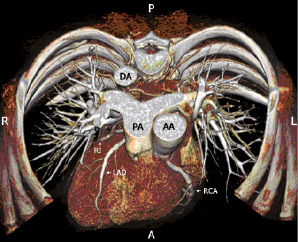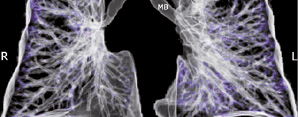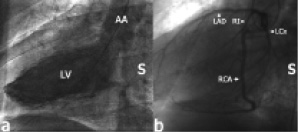A 46-year-old man with Kartagener’s Syndrome (primary ciliary diskinesia, autosomal recessive disorder with dextrocardia, situs inversus, bronchiectasis and paranasal sinusitis) presented with new onset angina. Coronary arteriography revealed severe three-vessel disease with occluded left anterior descending and circumflex coronary arteries. Due to severe pulmonary disease, coronary artery bypass surgery was not considered as the first therapeutic option. He underwent successful percutaneous multivessel revascularisation with implantation of paclitaxel-eluting stents. Control coronary angiography nine months after the procedure revealed no signs of restenosis. The patient remains asymptomatic at two years.

Figure 1. Dual source 64 multi-slice computed tomography volume-rendered image of the heart and the thoracic cage demonstrating the dextrocardia.
AA: ascending aorta; DA: descending aorta; LAD: left anterior descending; LCx: left circumflex; PA: pulmonary artery; RCA: right coronary artery; RI: ramus intermedius; A: anterior; L: left; P: posterior; R: right

Figure 2. Dual source 64 multi-slice computed tomography volume-rendered image of the lungs depicting the extensive bronchiectasis.
MB: main bronchus; L: left; R: right

Figure 3. Left heart ventriculography (a) and post-procedural simultaneous left and right coronary arteriography (b) in left anterior oblique projection showing the long axis of the heart.
AA: ascending aorta; LAD: left anterior descending; LCx: left circumflex; LV: left ventricle; RCA: right coronary artery; RI: ramus intermedius; S: spine
Online data supplement
Video 1. Angiography coronaries
Video 2. Angiography left ventricle
Video 3. MSCT coronaries
Video 4. MSCT dextrocardia

